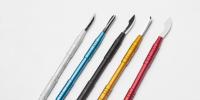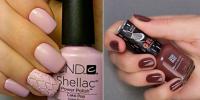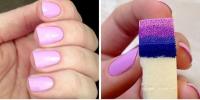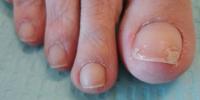Why do fingernails and toenails peel and break?
According to the condition of the nails, as well as the color of the skin, one can indirectly judge a person's health.
Women are more attentive to their nails, because having a beautiful manicure is the first rule of good manners for every self-respecting lady.
But men, if they see delamination or other violations of the nail plate, do not attach due importance to this problem. And it’s completely in vain, because circulatory disorders or the work of internal organs almost always affect the skin, hair and nails.
Therefore, in cases where nails often break and exfoliate, it is necessary to analyze what reasons provoked such changes.
Why do nails become brittle?
The appearance of the nail plates is influenced by both external (aggressive environmental influences) and internal factors (organism diseases).
External causes
- Contact of nails with harmful chemical compounds contained in detergents and household chemicals can cause brittle nails. The alkaline environment (pH) of such products destroys fat molecules not only on dirty dishes or linen, but also on the skin of the hands and nails.
- Some cosmetic preparations (including those for nails) also have excessive alkalinity, so fingernails exfoliate when they are used. Even if the label of a cosmetic product indicates that it is a “soft effect”, and against the background of its use, increased fragility of nails occurs, you should stop using this line of cosmetics.
- Frequent repainting of nails and the use of acetone-containing nail polish removers also degrease and dry out the keratin layer of the nail.
- Any manipulations that damage the nails (injuries, the habit of biting nails in children) often lead to the fact that they are badly exfoliated and broken. Incorrectly performed manicure injure nails no worse than concentrated chemistry. If you cut the cuticle with excessive zeal, affecting the deep nail layers, or roughly process the nail plate with a nail file, the nails become soft and exfoliate. To recover from such a manicure, you will have to wait until the damaged nail plate fully grows.
- Prolonged exposure to water leads to swelling and softening of the keratin layer of nails, so women who are constantly in contact with water ("washerwoman's hands") do not have long and strong nails. A powder or detergent dissolved in water will penetrate the upper layers faster nail and destroy it. In addition, a humid environment can be a good breeding ground for a fungal infection, which will make the nails even more brittle and unsightly.
- Exposure to cold also has a bad effect on the condition of the nails. At low temperatures, blood circulation in the hands worsens, so the fingertips very quickly begin to experience a lack of oxygen. With constant freezing, the nails quickly fade and exfoliate.
Internal causes
When the influence of external factors is excluded, or minimized, and the nails still exfoliate, it is necessary to consult a dermatologist and be examined for diseases.
Diseases that contribute to the deterioration of the appearance of the nail plates:
- Lack of vitamins A and E, which are necessary for the normal formation of collagen fibers and elastin. The lack of these vitamins can be caused both by an unbalanced diet (with diets for weight loss), and by diseases of the stomach or intestines, when the absorption of vitamins from food is disturbed.
- Infection of the intestines with helminths leads to a deterioration in the absorption of nutrients from food and, accordingly, to increased fragility of the nails.
- Lack of protein and some trace elements (calcium, silicon, zinc) in food, which are the building material for the nail.
- Heart defects, in which the peripheral blood supply to the fingers worsens. Under such conditions, the nail plate deforms, becomes thinner, turns pale and becomes like a “watch glass”.
- Anemia, in which, due to a lack of iron, there is a deficiency of hemoglobin. Less oxygen enters the capillaries of the fingers, which leads to separation and thinning of the nails.
- Diseases of the endocrine system (diabetes mellitus or impaired thyroid function).
- Long-term inflammatory diseases (tuberculosis, kidney infections, rheumatism, chronic bronchitis), as well as stress, lead to the depletion of the body's defenses, which, in turn, leads to breaking nails.
- In infants, soft exfoliating nails may be normal, but if the problem persists until admission to preschool, a thorough examination should be carried out for the presence of gastrointestinal diseases, worms or anemia in the child.
What can cause broken toenails?
The feet have less contact with chemically active substances than the hands. Therefore, of the external factors affecting the nail plates of the legs, injuries and wearing narrow shoes are the most relevant.
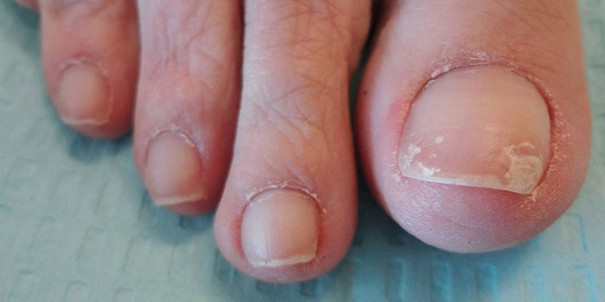
The same internal diseases that contribute to the change in the nail plates on the hands contribute to the thinning of the nails on the legs.
However, the most common cause of poor toenail health is a fungus. Onychomycosis (another name for fungal diseases) is manifested by thickening and delamination of the nail plate, swelling of the periungual ridge. Nails affected by onychomycosis change color to dirty gray or yellow, crumble.
How to treat brittle nails?
The doctor should deal with the determination of the root cause and treatment of the stratification of the nails. Often, by the appearance of the nails, you can make the correct diagnosis and determine what to do to restore hardness and shine to the nails.
- With external causes of a change in the state of the nail plates, it is necessary to exclude contact with an irritating substance (water, household chemicals, cold), work with rubber gloves, and prevent hypothermia of the hands.
- Manicure should be done carefully or entrust this procedure to a trusted master.
- If brittle nails are caused by internal diseases, the primary treatment will be the treatment of the underlying disease - hormonal correction, increased hemoglobin, replenishment of vitamin deficiency, and the fight against chronic foci of infection.
- Treatment of onychomycosis consists in the use of antifungal agents in the form of tablets, ointments and gels.
- You can drink a course of multivitamins and microelements on your own.
- Make baths to strengthen the nail plates with sea salt and vegetable oils. After the baths, it is recommended to apply a beeswax mask to the fingertips.
- A very effective remedy that requires minimal costs at home is lemon - fingers are dipped into its pulp for several minutes a day.
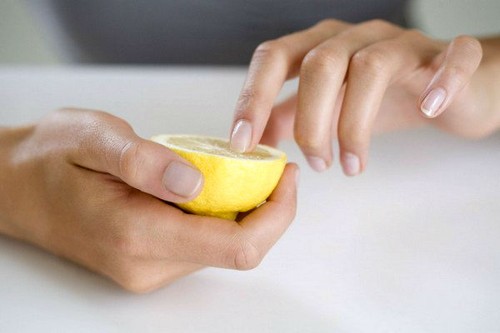
Attentive attitude to your health and proper skin care will help to avoid the problems of thinning and delamination of nails.

